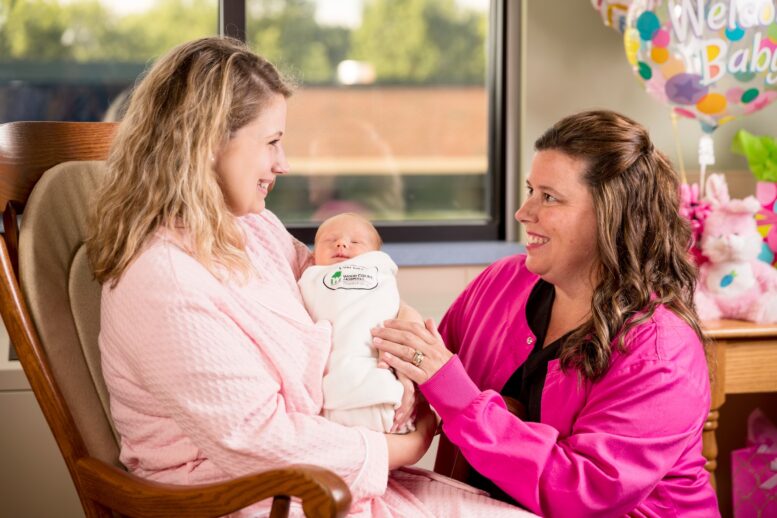By JULIE CARLE
BG Independent News
Babies born at Wood County Hospital’s Family Birthing Center are welcomed to the world with a sweet lullaby, the loving warmth of their family and top-notch care by the hospital’s labor and lactation nurses.
The hospital’s newborn feeding practices and maternity care to support breastfeeding earned high honors in the 2024 Maternity Practices in Infant Nutrition and Care survey, conducted by the Centers for Disease Control and Prevention.
On the 2024 survey, the birthing center received 100% adherence to immediate postpartum care standards, and high scores in breastfeeding education, rooming-in practices and discharge support.
As one of the 2,070 hospitals nationwide that participated in the survey, Wood County’s overall score averaged across six categories was 82 (out of 100).
“Of those participating hospitals, we surpassed the national and regional averages,” said Lisa Barndt, director of the hospital’s birthing center. “We scored higher than the average—nationally, locally and for like-sized maternity units” that deliver between 250-499 babies annually.”
Approximately 350 babies are born at Wood County Hospital each year.
For most of those births, “the care starts during the woman’s pregnancy with an educational component about breastfeeding through our Women’s Care and Rivercrest practices,” Barndt said.
Dawn Miller, the hospital’s lactation nurse, calls those women who are between
32 and 36 weeks pregnant to schedule pre-admission appointments. At the appointment, they fill out paperwork, tour the birthing center and learn about the culture of the hospital’s birthing center.
As a huge advocate for the benefits of breastfeeding babies, Miller talks with mothers in person and asks how she can assist them in the breastfeeding process.
In addition to the pre-delivery education that she offers, she also “supports them throughout, from the time they deliver to discharge and beyond,” Barndt said.
She provides in-person breastfeeding classes, one-on-one consultations and other educational opportunities.
“The more education and knowledge they get, maybe it helps to sway them more to consider breastfeeding and provide more breastfeeding success for them,” she said. Approximately 80% of the women choose to breastfeed.
The hospital earned 100% compliance for its immediate postpartum care standards, which includes skin-to-skin contact and continuous monitoring.
Skin-to-skin contact–a vital part of the transitional care to bond mother and baby–is provided after vaginal births and Caesarian (C-section) births, Barndt said. That connection of baby on the chest of the mother helps the baby’s ability to latch for breastfeeding and provides thermal regulation, which keeps them warm and stabilizes blood sugar.
“Our strong emphasis on rooming-in, ensures more than 90% of newborns remain with their mothers for 24 hours a day,” she said, further deepening that bond.
The nurses work at the bedside with the patients throughout the labor process and beyond to provide what’s best for the babies.
A culture of caring
Our nurses know how to give good care,” Barndt said. “Every day we stress essential behaviors–how we interact and show the families that they matter and that we care.”
The nurses are expected to be in the patient’s room throughout the labor process, helping to move the woman in a way to enhance labor. “If they are not in the room, they cannot do that,” Barndt explained.
The nurses sit with the mothers, interact with them, and let them ask questions to develop a care plan. “We make that birth plan with them, but we remind them they have a beautiful human inside who may dictate your care different from your plan,” Barndt said.
That kind of support done consistently and genuinely demonstrates the culture of the department.
“If you can bond with their patients, that builds trust and they find in that trust they can count on you to be there when they need you. That is powerful,” she said.
Barndt credited the hospital administration for permitting her to be able to “staff safely,” which makes it possible to give that kind of care.
This week, a mom who delivered at the end of December returned to the unit with a batch of home baked cookies. She told Barndt, “I delivered three my other kids elsewhere, but my husband and I both commented that the labor nurses stayed with us; they didn’t leave us to labor on our own.”
The birthing center also received high marks on the discharge component, which a lot of maternity units do not have that option available.
Nurses help schedule follow-up appointments for breastfeeding or to connect them with the Wood County Health Department’s Women Infants and Children (WIC) program.
Mothers who deliver their babies at Wood County will get a phone call within a week after they deliver to check on the newborn and mother. Mothers who are breastfeeding get a call from Miller within two to three days of discharge.
Before they are discharged, they are provided a phone number to call to set up an appointment with Miller to maintain the breastfeeding success.
“We are fortunate enough to be able to offer free lactation appointments to our women after they go home. There is no set number on how often they can meet with us,” Barndt said. “We have some that come back even within a year who are still lactating.”
There have been women who have delivered at other hospitals reach out when they hear about Miller’s free postpartum lactation support. “They see our culture in the hospital and the department. It’s a win-win for them and us,” she said.
The survey results “demonstrate how we practice care every day,” Barndt said. “It also shows our dedication to the nutritional care of our newborns. To be able to share that with the public makes me proud of where we are and how far we’ve come. That’s the work of these nurses and the lactation staff.”

